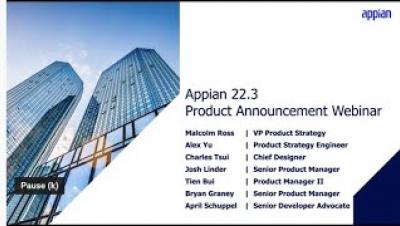Systems | Development | Analytics | API | Testing
Low Code
3 Ways to Accelerate Claims and Improve the Customer Experience
When it comes to the claims process, speed is of the utmost importance. However, too often, manual inefficient processes slow insurers down, resulting in settlement delays, a poor customer experience, and higher costs. And today’s economic climate only exacerbates claims leaders' challenges.
Forget SQL... CDM Is Where It's At
One of the main attributes of low-code development is speed. With the Appian Low-Code Platform, building, modifying and executing enterprise applications is fast and easy. And data is what powers those applications. That data has to be organized and managed, and this can slow down the development process.
Case Management Explainer
Low-Code Development is the Future of E-commerce Ecosystem
Appian RPA Opens Doors (...Er, Windows) to Expansion, Scale, and Transformation
With every iteration of automation technology that hits the market, one thing is clear: We are not far from a future where the only limit to what you can automate will be within the limits of your own imagination. Appian strives to open doors to the art of the possible by putting every automation capability you need to tackle any use case into our unified low-code platform. And in Appian 22.2, the latest product release, we’re opening Windows, too.
This Is No Time To Waffle On Complete Automation
Here’s something to know about me. I love breakfast food. With a capital “L.” And I have for my whole life. So it’s kind of surprising that I only recently added a crepe pan to my collection of kitchen tools. This crepe pan is great. It’s non-stick, but made from all-natural materials, and it’s the perfect size. I could even use it to cook bacon. Or scramble eggs. But I won't.
Appian 22.3 Product Announcement Webinar
Why Government CIOs Need to Rethink Their Tech Procurement Strategy
As government agencies and organizations look to modernize their technology stacks to keep up with changes in the workforce, aging solutions, and closing contracts, they’ll all set out with a similar process: submit an RFP, review submissions, and choose a vendor. Seems simple enough. But what government CIOs often don’t realize is that requiring proven, specific use cases may be limiting what their new (and likely expensive) technology investment can do for their organization.
The 28 API tools you need
With APIs taking over, more people are asking: What can I use to create my API? Although there are many different API standards and types, we will primarily focus on REST APIs. An API can be as simple as a single endpoint with one purpose, or it can be much more complex, like the AWS APIs with 1000s of endpoints and 100s of thousands of users. What all of these APIs have in common is that they have to be developed. We like to classify the development of APIs in 3 phases: Design, Build and Host.







